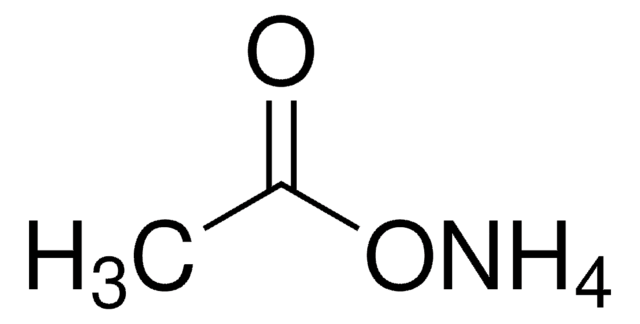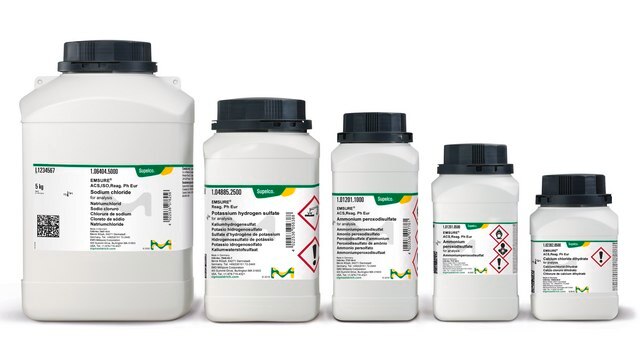09691
Ammonium acetate solution
BioUltra, for molecular biology, ~5 M in H2O
About This Item
Recommended Products
grade
for molecular biology
Quality Level
product line
BioUltra
form
liquid
concentration
~5 M in H2O
impurities
DNases, none detected
RNases, none detected
insoluble matter, passes filter test
phosphatases, none detected
proteases, none detected
ign. residue
≤0.01% (as SO4)
pH
6.2-7.5 (25 °C, 1 M in H2O)
density
1.07 g/mL at 20 °C
anion traces
chloride (Cl-): ≤5 mg/kg
nitrate (NO3-): ≤10 mg/kg
sulfate (SO42-): ≤10 mg/kg
cation traces
Al: ≤1 mg/kg
As: ≤0.1 mg/kg
Ba: ≤1 mg/kg
Bi: ≤1 mg/kg
Ca: ≤5 mg/kg
Cd: ≤1 mg/kg
Co: ≤1 mg/kg
Cr: ≤1 mg/kg
Cu: ≤1 mg/kg
Fe: ≤1 mg/kg
K: ≤20 mg/kg
Li: ≤1 mg/kg
Mg: ≤1 mg/kg
Mn: ≤1 mg/kg
Mo: ≤1 mg/kg
Na: ≤20 mg/kg
Ni: ≤1 mg/kg
Pb: ≤1 mg/kg
Sr: ≤1 mg/kg
Zn: ≤1 mg/kg
λ
1 M in H2O
UV absorption
λ: 260 nm Amax: 0.015
λ: 280 nm Amax: 0.01
SMILES string
CC([O-])=O.[H][N+]([H])([H])[H]
InChI
1S/C2H4O2.H3N/c1-2(3)4;/h1H3,(H,3,4);1H3
InChI key
USFZMSVCRYTOJT-UHFFFAOYSA-N
Looking for similar products? Visit Product Comparison Guide
Related Categories
Application
wgk_germany
WGK 1
flash_point_f
Not applicable
flash_point_c
Not applicable
ppe
Eyeshields, Gloves
Choose from one of the most recent versions:
Certificates of Analysis (COA)
Sorry, we don't have COAs for this product available online at this time.
If you need assistance, please contact Customer Support.
Already Own This Product?
Find documentation for the products that you have recently purchased in the Document Library.
Customers Also Viewed
Our team of scientists has experience in all areas of research including Life Science, Material Science, Chemical Synthesis, Chromatography, Analytical and many others.
Contact Technical Service
